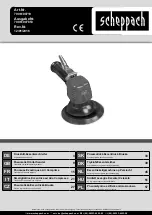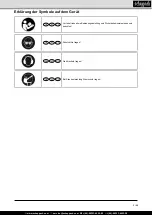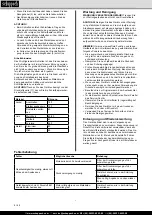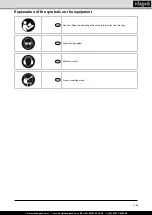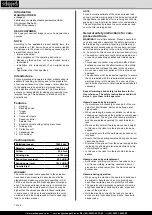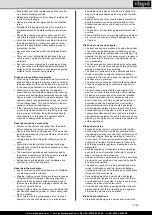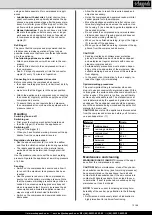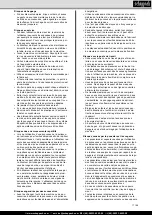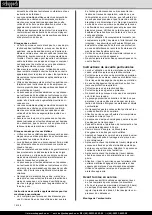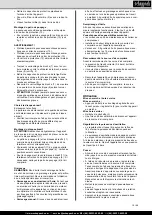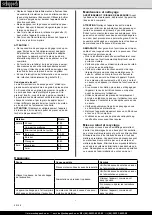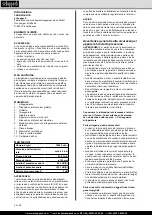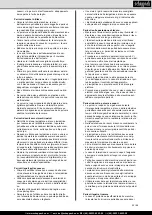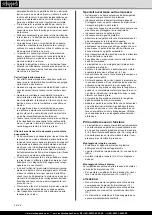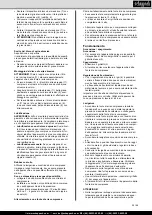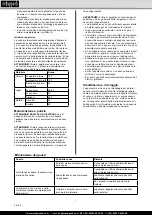
www.scheppach.com
+(49)-08223-4002-99
+(49)-08223-4002-58
11 І 68
flammable liquids, gases or dusts are located. Grin
-
ding work creates sparks which may ignite the dust
or fumes.
•
Keep children and other unauthorised personnel at
a safe distance when using compressed air tools.
Distractions can cause you to lose control over the
appliance.
•
The grinder is not insulated against electrical power
sources.
•
Ensure that there are no electrical cables, gas pipes,
etc., which can cause a hazard if damaged by use
of the tool.
Risks due to dust and vapours
•
The dust and vapours produced by using the sander
or polisher can be hazardous to health (e.g. cause
cancer, birth defects, asthma and/ or dermatitis); it is
essential to carry out a risk assessment in respect of
these risks and to implement corresponding regula
-
tory mechanisms.
•
The risk assessment should include all dust caused
by the use of the machine and any existing dust that
may be whirled up at the same time.
•
The sander or polisher is to be operated and main
-
tained in accordance with the recommendations
contained in this manual to keep the release of dust
and vapours to a minimum.
•
The exhaust air should be routed so that the raising
of dust in already dusty environments is kept to a
minimum.
•
If dusts or vapours are created, the main priority
must be to control these at the site of their release.
•
All inserts or accessories of the machine intended
for collecting, extracting or suppressing airborne
dust or vapours or should be used and serviced in
accordance with the manufacturer’s instructions.
•
Consumables/machine tools should be selected,
maintained and replaced in accordance with the re
-
commendations in this guide in order to avoid unne
-
cessary intensification of dust or vapour production.
•
Use breathing equipment as per the instructions pro
-
vided by your employer or as required by health and
safety regulations.
Risks due to noise
•
Excessive noise levels in conjunction with insuffici
-
ent hearing protection may lead to permanent hea
-
ring damage, hearing loss and other problems, such
as tinnitus (ringing, buzzing, whistling or humming
in your ears). Therefore it is essential that a risk as
-
sessment is carried out with respect to these risks
and that appropriate regulatory mechanisms are im
-
plemented.
•
Suitable regulatory mechanisms include measures
such as the use of insulation materials to avoid pin
-
ging occurring on the workpieces.
•
Use ear protection equipment as per the instructions
provided by your employer or as required by health
and safety regulations.
•
The sander or polisher is to be operated and main
-
tained in accordance with the recommendations
contained in this manual to reduce any unnecessary
increase of the noise levels.
•
Consumables/machine tools should be selected,
maintained and replaced in accordance with the re
-
commendations in this guide in order to avoid unne
-
cessary increase of the noise levels.
•
If the sander or polisher is equipped with a silencer,
always ensure that this in its place and is operatio
-
nal while the machine is in operation.
Risks due to vibrations
•
Vibrations can damage the nerves and cause mal
-
•
Ensure that your body is balanced and that you ha
-
ve a secure standing position.
•
Release the start/stop control in case of a disruption
to the electricity supply.
•
Use only lubricants recommended by the manufac
-
turer.
•
Suitable safety goggles must be worn; wearing of
protective gloves and safety clothing is recommen
-
ded.
•
Check the grinding disc before every use. Do not
use if this is cracked, broken or has been dropped.
•
Avoid direct contact with the movable grinding disc
to avoid squashing or cutting your hands or other
parts of the body. Always wear suitable gloves to
protect your hands.
•
Never use the machine without an abrasive attach
-
ment.
•
There is a risk of electrostatic discharge if the ma
-
chine is used on plastic and other non-conductive
materials.
•
Dust and vapours created by the grinding and san
-
ding can cause a potentially explosive atmosphere.
Always use a dust extraction or suppression system
suitable for the material being worked.
Risks due to repetitive movements
•
When using a sander or polisher to perform work-re
-
lated activities, operators may experience uncomfor
-
table sensations in their hands and arms, as well as
in the neck and shoulders or other parts of the body.
•
When using a sander or polisher, the operator
should adopt a comfortable posture whilst ensuring
a secure hold and avoiding awkward postures or po
-
sitions in which it is difficult to maintain balance. The
operator should change positions during the course
of long-lasting tasks. This can be helpful in the pre
-
vention of discomfort and fatigue.
•
If the operator notices symptoms such as persistent
or recurring illness, discomfort, throbbing, pain, ting
-
ling, burning or stiffness, these indications should
not be ignored. In this case, the operator should
consult a suitably qualified physician.
Hazards caused by accessories
•
Disconnect the sander or polisher from the power
before changing the tools or accessories.
•
Use only accessories and supplies of the sizes and
types recommended by the manufacturer of the san
-
der or polisher.
•
Cutting discs and machines for cutting may not be
used.
•
Avoid direct contact with the machine tool during
and after use, since this can have heated up or have
become sharp.
•
The maximum operating speed recommended by
the sander manufacturer must be equal to the rated
speed given on the machine or higher.
•
Self-adhesive grinding discs must be applied con
-
centrically on the mounting plate.
Hazards in the workplace
•
Keep your working area clean and well lit. Cluttered
or dark areas invite accidents.
•
Slipping, tripping up and falling are the main causes
of injuries at the workplace. Take note of surfaces
which could have become slippery through use of
the machine, and also any tripping hazards caused
by air or hydraulic hoses.
•
Proceed with caution in unknown surroundings. Hid
-
den hazards caused by power or other supply lines
may be present.
•
Do not work with the compressed air tool in areas
subject to the risk of explosions, or in areas where

